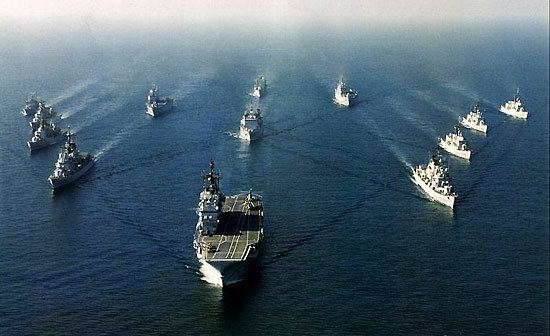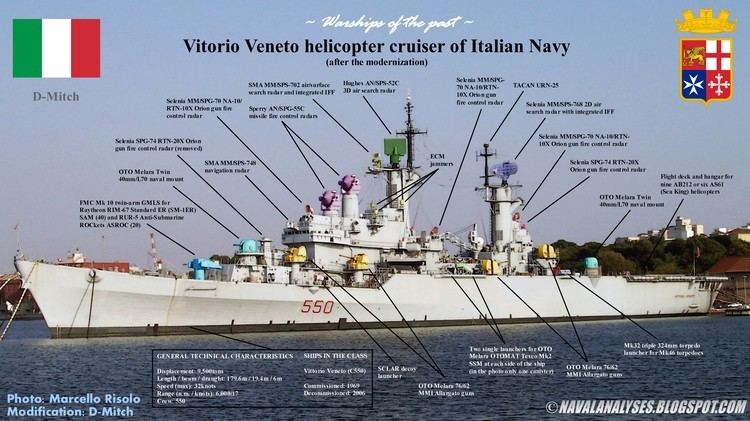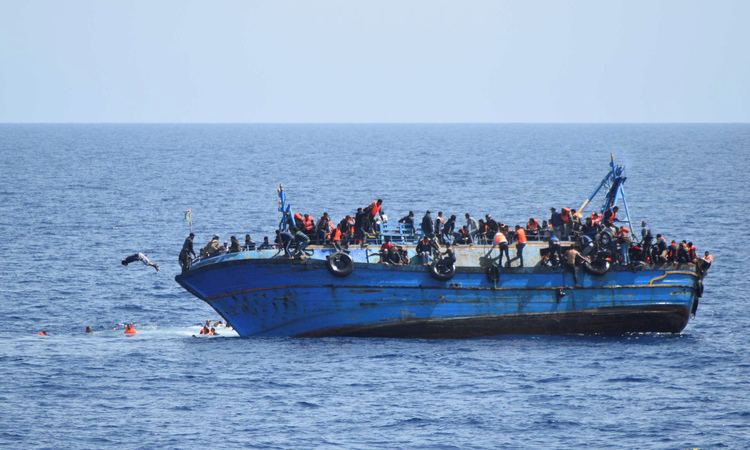Founded 1861 | Type Navy | |
 | ||
Size 30,923 personnel184 vessels (incl. minor auxiliaries)70 aircraft March La Ritirata ("Ritirata" in Italian means the return of soldiers to their barrack, or in this case of sailors to their ship after a leave) by Tommaso Mario Similar Italian Army, Italian Armed Forces, Italian Air Force, Carabinieri, Regia Marina Profiles | ||
The Italian Navy (Italian: Marina Militare, lit. "Military Navy"; abbreviated as MM) is the maritime defence force of the Italian Republic. It is one of the four branches of Italian Armed Forces and was formed in 1946 from what remained of the Regia Marina (Royal Navy) after World War II. As of August 2014, the Italian Navy had a strength of 30,923 active personnel with approximately 184 vessels in service, including minor auxiliary vessels.
Contents
- Before and during World War II
- After World War II
- The peace treaty
- The entry into NATO
- Naval ensign
- Organization
- Coast Guard
- Corps
- Fleet
- Ships and submarines
- Aircraft
- Future
- References

Before and during World War II

The Regia Marina was formed on March 17, 1861, after the proclamation of the Kingdom of Italy. The Italian Navy assumed its present name after the Italian monarchy was abolished following a popular referendum held on June 2, 1946.
After World War II

At the end of its five years involvement in World War II, Italy was a devastated nation. After the end of hostilities the Regia Marina, which at the beginning of the war was the fourth largest navy in the world with a mix of modernised and new battleships, started a long and complex rebuilding process. The important combat contributions of the Italian naval forces after the signing of the armistice with the Allies on September 8, 1943, and the subsequent cooperation agreement on September 23, 1943, left the Regia Marina in a poor condition, with much of its infrastructure and bases unusable and its ports mined and blocked by sunken ships. However, a large number of its naval units had survived the war, albeit in a low efficiency state, which was due to the conflict and the age of many vessels. The vessels that remained were:

The peace treaty

The peace treaty signed on February 10, 1947 in Paris was onerous for Regia Marina. Apart from territorial and material losses, also the following restrictions were imposed:

The treaty also ordered Italy to put the following ships at the disposals of the victorious nations United States, Soviet Union, Great Britain, France, Greece, Yugoslavia and Albania as war compensation:
The total displacement, battleships excluded, of the future navy was not allowed to be greater than 67,500 tons, while the staff was capped at 25,000 men.
The entry into NATO
Great changes in the international political situation, which were developing into the Cold War, convinced the United Kingdom and United States to discontinue the transfer of Italy's capital ships as war reparations. Some had already been dismantled in La Spezia between 1948 and 1955, including the flagship aircraft carrier Aquila. However, the Soviet Union demanded the surrender of the battleship Giulio Cesare and other naval units designated for transfer. The cruisers Attilio Regolo and Scipione Africano became the French Chateaurenault and Guichen, while Eugenio di Savoia became the Greek Helli. After break up and/or transfers, only a small part of the fleet remained to be recommissioned into the Marina. As Western attention turned to the Soviets and the Mediterranean Sea, Italian seas became one of the main sites of confrontation between the two superpowers, contributing to the re-emergence of Italy's naval importance thanks to her strategic geographical position.
With the new elections in 1946, the Kingdom of Italy became a Republic, and the Regia Marina took the name of Marina Militare (Military Navy). As the Marshall Plan began to rebuild Italy and Europe was rapidly being divided into two geo-politically antagonistic blocs, Italy began talks with the United States to guarantee adequate security considerations. The US government in Washington wished to keep its own installations on the Italian Peninsula and relaxed the Treaty restrictions by including Italy in the Mutual Defense Assistance Programme (MDAP). On April 4, 1949, Italy joined the North Atlantic Treaty Organisation (NATO) and, in order for the navy to contribute actively in the organization, the Treaty restrictions were definitively repealed by the end of 1951, with the consent of all of Western nations.
Within NATO, the Marina Militare was assigned combat control of the Adriatic Sea and Strait of Otranto, as well as the defence of the naval routes through the Tyrrhenian Sea. To ensure these tasks a "Studio sul potenziamento della Marina italiana in relazione al Patto Atlantico" (Study about the development of the Italian Navy with reference to the Atlantic Pact) was undertaken, which researched the structures and the methods for the development of the Marina Militare. This solution required a great economic effort to rebuild and transform the fleet; it also required aid from the United States to reach the necessary standards. Progress was slow due to economic pressures on Italy (because of the tremendous resources needed for post-war rebuilding of Italy and its military-industrial complex) and due to opposition from other European governments. These nations were concerned at seeing an Italian Navy capable of rivaling the Western naval forces, so they imposed political obstacles to slow Italian naval development.
Naval ensign
The ensign of the Italian Navy is the Italian tricolour defaced with the coat of arms of the Marina Militare. The quarters refer to the four Medieval Italian Thalassocracies, or "Maritime Republics" (Italian: Repubbliche Marinare):
The shield has a golden crown, that distinguishes military vessels from merchant: the crown, "corona rostrata", was proposed in 1939 by Admiral Domenico Cavagnari to the Government, as an acknowledgement of the Italian Navy's origin in Roman times. In the proposal, Adm. Cavagnari wrote that "in order to recall the common origin [of the Navy] from the Roman sailorship, the Insignia will be surmounted by the towered Crown with rostra, the emblem of honour and valour the Roman Senate awarded to the leaders of naval victories, conquerors of lands and cities across the seas".
A further difference is that St. Mark's lion, symbolising the Republic of Venice, does not hold the gospel in its paw (as it does on the civil ensign, where the book is open at the words "Pax tibi Marce, evangelista meus", meaning "Peace to you Mark, my Evangelist") and is wielding a sword instead: such an image is consistent with the pictorial tradition from Venetian history, in which the book is shown open during peacetime and closed during wartime.
Organization
In 2012 the Navy began a restructuring process that will see a 21% decrease in personnel by 2025. A new structure was implemented in January 2014. The command structure is depicted below:
Reporting to the Logistics Command is Maritime Command – divided into four areas who provide logistic support for their areas.
Coast Guard
The Corps of the Port Captaincies – Coast Guard (Italian language: Corpo delle Capitanerie di porto – Guardia costiera') is the coast guard of Italy and is part of the Italian Navy under the control of the Ministry of Infrastructures and Transports. In Italy, it is commonly known as simply the Guardia costiera. The Coast Guard has approximately 11 000 staff.
Corps
Marina Militare is divided into seven corps (by precedence) and one:
Fleet
Command of the Italian Fleet (ships, submarines and amphibious forces) and Naval aviation falls under Commander in Chief Naval Fleet
Ships and submarines
Today's Marina Militare is a modern navy with ships of every type. The fleet is in continuous evolution, and as of October 2016 oceangoing fleet units include: two aircraft carriers, three amphibious assault ships, four destroyers, 14 frigates and seven attack submarines. Patrol and littoral warfare units include: 10 offshore patrol vessels and four corvettes. Ten mine countermeasure vessels, four coastal patrol boats, and a varied fleet of auxiliary ships are also in service.
The flagship of the fleet is the carrier Cavour.
Aircraft
The Italian Navy operates a diverse fleet of aircraft including fixed-wing, rotary and UAVs.
Future
The 2014 Naval Act allocated Euro 5.4 billion for the following projects:
Planned but not yet financed:
